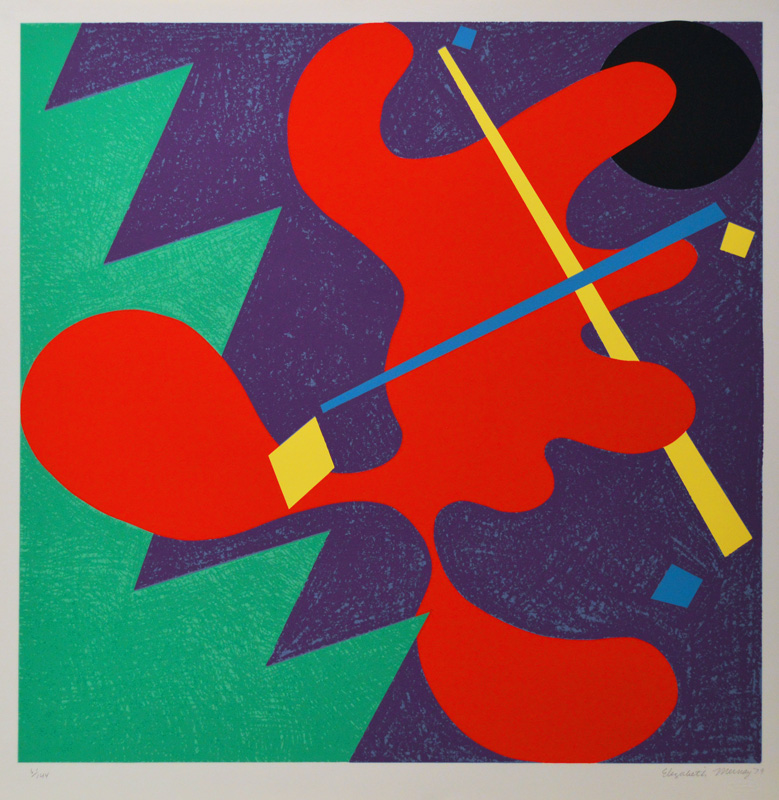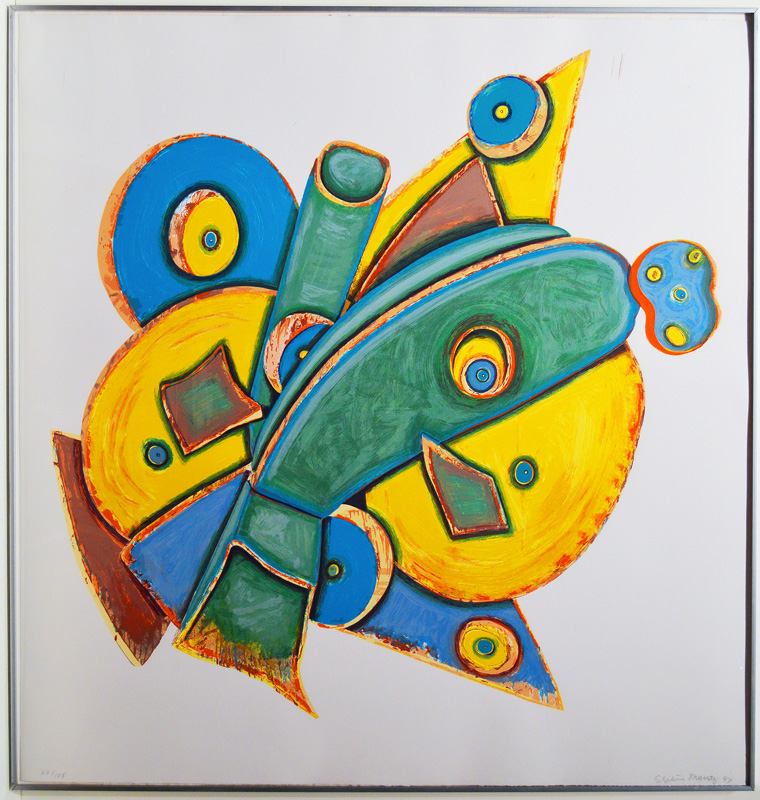|
Roberta Smith's NY Times obituary (8/13/2007) tells us most of what we need to know to understand Elizabeth Murray's place in the recent history of Amerian art: "Elizabeth Murray, a New York painter who reshaped Modernist abstraction into a high-spirited, cartoon-based, language of form whose subjects included domestic life, relationships and the nature of painting itself, died yesterday at her home in upstate New York. She was 66 and lived in TriBeCa and in Washington County, N.Y. The cause was complications of lung cancer, said Douglas Baxter, president of PaceWildenstein, which has represented her work since 1995. An intense, unpretentious woman with vivid blue eyes and an unruly nest of prematurely white hair, Ms. Murray received a full-dress retrospective spanning her 40-year career at the Museum of Modern Art in 2006, one of handful of women to be so honored. As the anonymous introduction to a show of her prints at the Stanford University Cantor Art Msuem this past winter summed it up, "She received numerous awards for her work, including the Skowhegan Medal in Painting in 1986 and a MacArthur Foundation “genius” award in 1999. She was also honored by MoMA in 2005 with a retrospective exhibition, a distinction previously given only to three women: Louise Bourgeois, Lee Krasner and Helen Frankenthaler. Her works are in many major public collections, including those of the Solomon R. Guggenheim Museum, the Hirshhorn Museum and Sculpture Garden, the Museum of Modern Art, the Whitney Museum of American Art, the Art Institute of Chicago and the Carnegie Museum of Art. " Like her paintings, many of her prints seem to yearn for 3-dimensionality: "Murray's [print]work is also characterized by an exuberant fracturing and synthesizing. The pieces are explosive in gesture, often in color, and in shape. Layered, both visually and literally, the works seem to be making themsleves as we watch them, and the possibilities for visual expansion seem limitless. There is often a puzzlelikke quality to the work especially after 1980, but one senses that the parts will never quite fit. Murray's combinations of color, line, shape, and surface seem unwilling to cohere. One senses that Murray draws, consciously or unconsciously, from both art and her surroundings: architectural expanses, Miróesque figural elements, distorted household forms—all enter into these oddly personal and unquantifiable compositions" (Ruth Fine, in A Graphic Muse: Prints by Contemporary American Women, edited Richard S. Field and Ruth E. Fine (NY: Hudson Hills Press, 1987), p. 119. One observes, especially in Deborah Solomon's long feature essay in The New York Times Magazine (31 March 1994, front cover, pp. 20-25, 40, 46), how smart Murray is and how easy it makes it for those writing about her: "A Murray painting is easy to recognize. More often than not, it consists of a big canvas loaded up with forms and colors that bounce off one another in an anarchic, ebullient way. While her paintings at first may appear abstract, they are full of references to human figures, rooms and conversations. Narratives quickly present themselves. The pictures can suggest squabbling children, for instance, or a woman sitting alone at a table, feeling edgy. But usually their meanings aren't so literal, and their protagonists aren't people but personable shapes and objects: cracked cups, chubby paint brushes and overturned tables (with legs that can vehemently kick) are among the artist's favorite motifs. While abstract art was conceived in the early years as a quest for transcendent emotion, Murray uses its simplified forms to get at life's frayed, dangling ends" (p. 25).
Partial bibliography: David P. Becker and Keith S. Brintzenhofe, Elizabeth Murray Prints 1979-1990 (West Islip, NY: U.L.A.E, 1990; the catalogue raisonée published to accompany an exhibtion of Murray's prints that travelled from the Barbara Krakow Gallery, Boston, to the Museum of Art at Olin Arts Center, Bates College, Lewiston, ME; the David Winton Bell Gallery, Brown University, Providence, RI; the Davison Art Center, Wesleyan University, Middletown, CT, and the Florida Gulf Coast Art Center, Belleair, FL); Sue Graze and Kathy Halbrech, ed. Elizabeth Murray: Paintings and Drawings (NY: Harry N. Abrams, 1987, with essays by Roberta Smith and Notes by Clifford S. Ackely; this work accompanied a show that went from the Dallas Museum of Art to the Albert & Vera List Visual Arts Center, MIT and the Museum of Fine Arts, Boston; the Museum of Contemporary Art (Los Angeles); the Des Moines Art Center; the Walker Art Center, Minnapolis; and the Whiteny Museum of American Art, NY); Michael Kimmelman, At the Met with Elizabeth Murray: Looking for the Magis and the Love in Painting (NY Times, 21 October 1994); Elaine A. King, Elizabeth Murray: Drawings 1980-1986 (Pittsburgh: Carnegie Mellon University Press, 1986, with essays by Ann Sutherland Harris and Paul Gardner); Robert Storr, Elizabeth Murray: Pop (Up) Art (NY: Museum of Modern Art, 1995; Robert Storr, Elizabeth Murray (NY: Museum of Modern Art, 1996; Kirk Varnedoe and Elizabeth Murray, Artist's Choice: Elizabeth Murray: Modern Women (NY: MoMA, 1995)
|
|
|

